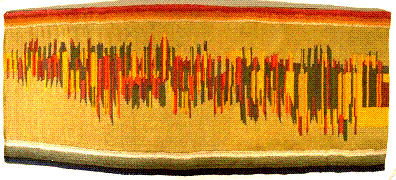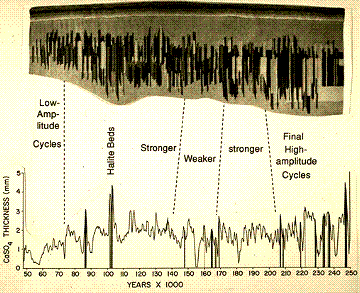
I thought that most of the mystery had been removed
from the Castile. But a few years after we published the first plot, I happened
to be invited to Sunday dinner by a neighbor. She had invited several other
friends and neighbors. One of the neighbors, whom I had yet to meet, was
a weaver and she was going to unveil a large and colorful wall hanging that
had taken her many months to complete. The weaver, Mary Ann Moraga, had
previously used earth themes in her tapestries and had once been a musician.
The new tapestry was long and narrow and after dinner we gathered along
both sides of the living room for the unrolling.

I sat opposite the artist, which only added to my reaction
because I was looking at the weaving in the same way I was used to seeing
the climate record from the Castile. As Mary Ann unrolled her creation I
saw the plot of the Castile, as we had published it, within the colorful
threads of the tapestry.

How could it be? What I saw was the same series of climate
oscillations so painstakingly assembled from our annual layers! It wasn't
a perfect copy, but it brought goose flesh. I noticed first that the strong,
2500-year oscillation in the Castile also dominated the weaving. At the
start, on the left, was the first big shift in climate in the Castile, followed
by a steady increase in the amplitude of 2500-year cycles. This was a time
when the Delaware Basin was new and deep and filled with water, and when
the beat of climate had less of an effect on the thickness of the annual
layers of sediment.
Her sequence had two large maxima near 100,000 years, at a time when our basin had nearly dried up and made two thick beds of halite. Then both records settled into a pattern of equilibrium, with stronger and weaker pulses in the tapestry matching stronger and weaker oscillations in ancient weather patterns. Then, near the end, when the basin was full, massive beds of salt and thick beds of gypsum in the Castile became a crescendo of strong and prolonged pulsations in the weaving.